Anarcha-feminism
Anarcha-feminism, also referred to as anarchist feminism and anarchx-feminism,[1] combines anarchism with feminism. Anarcha-feminism generally posits patriarchy and traditional gender roles as manifestations of involuntary coercive hierarchy that should be replaced by decentralized free association. Anarcha-feminists believe that the struggle against patriarchy is an essential part of class conflict and the anarchist struggle against the state and capitalism. In essence, the philosophy sees anarchist struggle as a necessary component of feminist struggle and vice versa. L. Susan Brown claims that "as anarchism is a political philosophy that opposes all relationships of power, it is inherently feminist".[2] Contrary to popular belief and contemporary association with radical feminism, anarcha-feminism is not an inherently militant outlook. It is described to be an anti-authoritarian, anti-capitalist, anti-oppressive philosophy, with the goal of creating an "equal ground" between all genders. Anarcha-feminism suggests the social freedom and liberty of women without needed dependence upon other groups or parties.
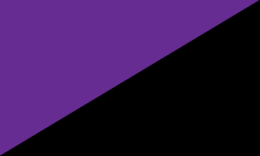
Origins
Mikhail Bakunin opposed patriarchy and the way the law "[subjected women] to the absolute domination of the man". He argued that "[e]qual rights must belong to men and women" so that women could "become independent and be free to forge their own way of life". Bakunin foresaw the end of "the authoritarian juridical family" and "the full sexual freedom of women".[3][4] On the other hand, Pierre-Joseph Proudhon viewed the family as the most basic unit of society and of his morality and believed that women had the responsibility of fulfilling a traditional role within the family.[5][6]
Since the 1860s, anarchism's radical critique of capitalism and the state has been combined with a critique of patriarchy. Anarcha-feminists thus start from the precept that modern society is dominated by men. Authoritarian traits and values—domination, exploitation, aggression and competition—are integral to hierarchical civilizations and are seen as "masculine". In contrast, non-authoritarian traits and values—cooperation, sharing, compassion and sensitivity—are regarded as "feminine" and devalued. Anarcha-feminists have thus espoused creation of a non-authoritarian, anarchist society. They refer to the creation of a society based on cooperation, sharing and mutual aid as the "feminization of society".[3]
Anarcha-feminism began with late 19th and early 20th century authors and theorists such as anarchist feminists Emma Goldman, Voltairine de Cleyre and Lucy Parsons.[7] In the Spanish Civil War, an anarcha-feminist group, Mujeres Libres ("Free Women"), linked to the Federación Anarquista Ibérica, organized to defend both anarchist and feminist ideas.[8] Stirnerist Nietzschean feminist Federica Montseny held that the "emancipation of women would lead to a quicker realization of the social revolution" and that "the revolution against sexism would have to come from intellectual and militant 'future-women'". According to this Nietzschean concept of Federica Montseny's, women could "realize through art and literature the need to revise their own roles".[9] In China, the anarcha-feminist He Zhen argued that without women's liberation society could not be liberated.[10]
Virginia Bolten and La Voz de la Mujer
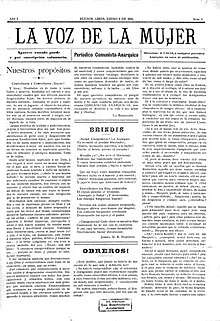
In Argentina, Virginia Bolten is responsible for the publication of a newspaper called La Voz de la Mujer (English: The Woman's Voice), which was published nine times in Rosario between 8 January 1896 and 1 January 1897 and was briefly revived in 1901. A similar paper with the same name was reportedly published later in Montevideo, which suggests that Bolten may also have founded and edited it after her deportation.[11] La Voz de la Mujer described itself as "dedicated to the advancement of Communist Anarchism". Its central theme was the multiple natures of women's oppression. An editorial asserted: "We believe that in present-day society, nothing and nobody has a more wretched situation than unfortunate women". They said that women were doubly oppressed by both bourgeois society and men. Its beliefs can be seen from its attack on marriage and upon male power over women. Its contributors, like anarchist feminists elsewhere, developed a concept of oppression that focused on gender. They saw marriage as a bourgeois institution which restricted women's freedom, including their sexual freedom. Marriages entered into without love, fidelity maintained through fear rather than desire and oppression of women by men they hated were all seen as symptomatic of the coercion implied by the marriage contract. It was this alienation of the individual's will that the anarchist feminists deplored and sought to remedy, initially through free love and then more thoroughly through social revolution.[12]
Individualist anarchism and the free love movement

An important topic within individualist anarchism is free love.[13] Free love advocates sometimes traced their roots back to Josiah Warren and to experimental communities, which viewed sexual freedom as a clear, direct expression of an individual's self-ownership. Free love particularly stressed women's rights since most sexual laws discriminated against women, such as marriage laws and anti-birth control measures.[13] The most important American free love journal was Lucifer the Lightbearer (1883–1907), edited by Moses Harman and Lois Waisbrooker.[14] Ezra and Angela Heywood's The Word was also published from 1872–1890 and in 1892–1893.[13] M. E. Lazarus was also an important American individualist anarchist who promoted free love.[13] In Europe, the main propagandist of free love within individualist anarchism was Émile Armand.[15] He proposed the concept of "la camaraderie amoureuse" to speak of free love as the possibility of voluntary sexual encounter between consenting adults. He was also a consistent proponent of polyamory.[15] In France, there was also feminist activity inside French individualist anarchism as promoted by individualist feminists Marie Küge, Anna Mahé, Rirette Maîtrejean and Sophia Zaïkovska.[16]
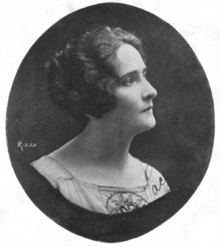
Brazilian individualist anarchist Maria Lacerda de Moura lectured on topics such as education, women's rights, free love and antimilitarism. Her writings and essays landed her attention not only in Brazil, but also in Argentina and Uruguay. In February 1923, she launched Renascença, a periodical linked with the anarchist, progressive and freethinking circles of the period. Her thought was mainly influenced by individualist anarchists such as Han Ryner and Émile Armand.[17]
Voltairine de Cleyre
Voltairine de Cleyre was an American anarchist writer and feminist. She was a prolific writer and speaker, opposing the state, marriage and the domination of religion in sexuality and women's lives. She began her activist career in the freethought movement. Although initially drawn to individualist anarchism, she evolved through mutualism to an anarchism without adjectives.
De Cleyre was a colleague of Emma Goldman, with whom she respectfully disagreed with on many issues. Many of her essays were in the Collected Works of Voltairine de Cleyre, published posthumously by Mother Earth in 1914.
In her 1895 lecture entitled Sex Slavery, de Cleyre condemns ideals of beauty that encourage women to distort their bodies and child socialization practices that create unnatural gender roles. The title of the essay refers not to traffic in women for purposes of prostitution, although that is also mentioned, but rather to marriage laws that allow men to rape their wives without consequences. Such laws make "every married woman what she is, a bonded slave, who takes her master's name, her master's bread, her master's commands, and serves her master's passions".[18]
Emma Goldman
Although hostile to first-wave feminism and its suffragist goals, Emma Goldman advocated passionately for the rights of women and is today heralded as a founder of anarcha-feminism. In 1897, she wrote: "I demand the independence of woman, her right to support herself; to live for herself; to love whomever she pleases, or as many as she pleases. I demand freedom for both sexes, freedom of action, freedom in love and freedom in motherhood".[19] In 1906, Goldman wrote a piece entitled "The Tragedy of Woman's Emancipation"[20] in which she argued that traditional suffragists and first-wave feminists were achieving only a superficial good for women by pursuing the vote and a movement from the home sphere. She also writes that in the ideal world women would be free to pursue their own destinies, yet "emancipation of woman, as interpreted and practically applied today, has failed to reach that great end".[21] She pointed to the "so-called independence"[22] of the modern woman whose true nature—her love and mother instincts—were rebuked and stifled by the suffragist and early feminist movements. Goldman's arguments in this text are arguably much more in line with the ideals of modern third-wave feminism than with the feminism of her time, especially given her emphasis on allowing women to pursue marriage and motherhood if they so desired. In Goldman's eyes, the early twentieth century idea of the emancipated woman had a "tragic effect upon the inner life of woman"[23] by restricting her from fully fulfilling her nature and having a well-rounded life with a companion in marriage.
A nurse by training, Goldman was an early advocate for educating women about birth control. Like many contemporary feminists, she saw abortion as a tragic consequence of social conditions and birth control as a positive alternative. Goldman was also an advocate of free love and a strong critic of marriage. She saw early feminists as confined in their scope and bounded by social forces of Puritanism and capitalism. She wrote: "We are in need of unhampered growth out of old traditions and habits. The movement for women's emancipation has so far made but the first step in that direction".[24][25] When Margaret Sanger, an advocate of access to birth control, coined the term "birth control" and disseminated information about various methods in the June 1914 issue of her magazine The Woman Rebel, she received aggressive support from Goldman. Sanger was arrested in August under the Comstock laws, which prohibited the dissemination of "obscene, lewd, or lascivious articles",[26] including information relating to birth control. Although they later split from Sanger over charges of insufficient support, Goldman and Reitman distributed copies of Sanger's pamphlet Family Limitation (along with a similar essay of Reitman's). In 1915, Goldman conducted a nationwide speaking tour in part to raise awareness about contraception options. Although the nation's attitude toward the topic seemed to be liberalizing, Goldman was arrested in February 1916 and charged with violation of the Comstock Law. Refusing to pay a $100 fine, she spent two weeks in a prison workhouse, which she saw as an "opportunity" to reconnect with those rejected by society.[27]
Goldman was also an outspoken critic of prejudice against homosexuals. Her belief that social liberation should extend to gay men and lesbians was virtually unheard of at the time, even among anarchists.[28] As Magnus Hirschfeld wrote, "she was the first and only woman, indeed the first and only American, to take up the defense of homosexual love before the general public".[29] In numerous speeches and letters, she defended the right of gay men and lesbians to love as they pleased and condemned the fear and stigma associated with homosexuality. As Goldman wrote in a letter to Hirschfeld: "It is a tragedy, I feel, that people of a different sexual type are caught in a world which shows so little understanding for homosexuals and is so crassly indifferent to the various gradations and variations of gender and their great significance in life".[29]
Milly Witkop
Milly Witkop was a Ukrainian-born Jewish anarcho-syndicalist, feminist writer and activist. She was the common-law wife of Rudolf Rocker. In November 1918, Witkop and Rocker moved to Berlin; Rocker had been invited by Free Association of German Trade Unions (FVdG) chairman Fritz Kater to join him in building up what would become the Free Workers' Union of Germany (FAUD), an anarcho-syndicalist trade union.[30] Both Rocker and Witkop became members of the FAUD.[31] After its founding in early 1919, a discussion about the role of girls and women in the union started. The male-dominated organization had at first ignored gender issues, but soon women started founding their own unions, which were organized parallel to the regular unions, but still formed part of the FAUD. Witkop was one of the leading founders of the Women's Union in Berlin in 1920. On October 15, 1921, the women's unions held a national congress in Düsseldorf and the Syndicalist Women's Union (SFB) was founded on a national level. Shortly thereafter, Witkop drafted Was will der Syndikalistische Frauenbund? (What Does the Syndicalist Women's Union Want?) as a platform for the SFB. From 1921, the Frauenbund was published as a supplement to the FAUD organ Der Syndikalist, Witkop was one of its primary writers.[31]
Witkop reasoned that proletarian women were exploited not only by capitalism like male workers, but also by their male counterparts. She contended therefore that women must actively fight for their rights, much like workers must fight capitalism for theirs. She also insisted on the necessity of women taking part in class struggle and that housewives could use boycotts to support this struggle. From this, she concluded the necessity of an autonomous women's organization in the FAUD. Witkop also held that domestic work should be deemed equally valuable to wage labor.[32]
Mujeres Libres
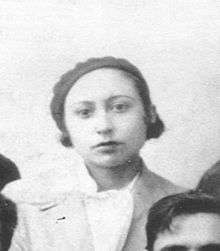

Mujeres Libres (English: Free Women) was an anarchist women's organization in Spain that aimed to empower working class women. It was founded in 1936 by Lucía Sánchez Saornil, Mercedes Comaposada and Amparo Poch y Gascón and had approximately 30,000 members. The organization was based on the idea of a "double struggle" for women's liberation and social revolution and argued that the two objectives were equally important and should be pursued in parallel. In order to gain mutual support, they created networks of women anarchists. Flying day-care centres were set up in efforts to involve more women in union activities.[33]
The organization also produced propaganda through radio, traveling libraries and propaganda tours in order to promote their cause. Organizers and activists traveled through rural parts of Spain to set up rural collectives and support for women.[34] To prepare women for leadership roles in the anarchist movement, they organized schools, women-only social groups and a women-only newspaper to help women gain self-esteem and confidence in their abilities and network with one another to develop their political consciousness. Many of the female workers in Spain were illiterate and the Mujeres Libres sought to educate them through literacy programs, technically oriented classes and social studies classes. Schools were also created for train nurses to help injured in emergency medical clinics.[34] Medical classes also provided women with information on sexual health and pre and post-natal care.[34] The Mujeres Libres also created a woman run magazine to keep all of its members informed. The first monthly issue of Mujeres Libres was published on May 20, 1936 (ack 100). However, the magazine only had 14 issues and the last issue was still being printed when the Spanish Civil War battlefront reached Barcelona, and no copies survived. The magazine addressed working class women and focused on "awakening the female conscience toward libertarian ideas".[35]
Lucía Sánchez Saornil
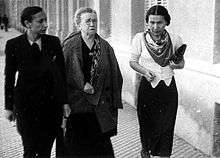
Lucía Sánchez Saornil (December 13, 1895 – June 2, 1970), was a Spanish poet, militant anarchist and feminist. She is best known as one of the founders of Mujeres Libres. She served in the Confederación Nacional del Trabajo (CNT) and Solidaridad Internacional Antifascista (SIA). By 1919, she had been published in a variety of journals, including Los Quijotes, Tableros, Plural, Manantial and La Gaceta Literaria. Working under a male pen name, she was able to explore lesbian themes[36] at a time when homosexuality was criminalized and subject to censorship and punishment. Writing in anarchist publications such as Earth and Freedom, the White Magazine and Workers' Solidarity, Lucía outlined her perspective as a feminist. Although quiet on the subject of birth control, she attacked the essentialism of gender roles in Spanish society. In this way, Lucía established herself as one of the most radical of voices among anarchist women, rejecting the ideal of female domesticity which remained largely unquestioned. In a series of articles for Workers' Solidarity, she boldly refuted Gregorio Marañón's identification of motherhood as the nucleus of female identity.[37]
Italian migrant women

In the late 19th and early 20th centuries, Paterson, New Jersey was a major center of the anarchist movement. Most of the anarchists in the area were Italian migrants who worked in the mills and women played an important role in the movement.[38]
Northern Italian migrants Maria Roda, Ernestina Cravello and Ninfa Baronio founded Paterson's Gruppo Emancipazione della Donna (Women's Emancipation Group) in 1897. The group gave lectures, wrote for the anarchist press, and published pamphlets. They also formed the Club Femminile de Musica e di Canto (Women's Music and Song Club) and the Teatro Sociale (Social Theater). The Teatro performed plays which challenged Catholic sexual morality[39] and called for the emancipation of women. Their plays stood in marked contrast to other radical works in which women were depicted as victims in need of rescuing by male revolutionaries.[40] They often traveled to perform their plays, and connected with other Italian anarchist women in Hoboken, Brooklyn, Manhattan and New London, Connecticut. The Paterson group met regularly for about seven years and inspired other women to form similar groups.[41] Their Southern Italian contemporaries included Elvira Catello in East Harlem, who ran a popular theater group and a radical bookstore;[42] Maria Raffuzzi in Manhattan, who co-founded Il Gruppo di Propaganda Femminile (Women's Propaganda Group) in 1901;[43] and Maria Barbieri, an anarchist orator who helped organize the silk workers in Paterson.[44]
Anarchist Italian women such as Maria Roda flouted convention and Catholic teaching by rejecting traditional marriage in favor of "free unions". In practice, these unions often turned out to be lifelong and monogamous, with the division of labor falling along traditional lines. The anarchist writer Ersilia Cavedagni believed that "the woman is and will always be the educator of the family, that which has and will always have the most direct and the most important influence on the children".[45]
Contemporary developments

In "The Tyranny of Tyranny", Cathy Levine noted that feminists often practiced anarchist organizing ethics in the 1970s as "all across the country independent groups of women began functioning without the structure, leaders and other factotems of the male Left, creating independently and simultaneously, organisations similar to those of anarchists of many decades and locales."[46] This was as a counter to dominant Marxist forms of organizing that were hierarchical and authoritarian.
Anarchism gives rise to feminism in West Germany
A prominent example for this gives the founding of the Frauenzentrum Westberlin in 1973: “We simply skipped the step of a theoretical platform, which was a must in other groups. Even before this meeting there was a consensus, so that we didn’t need a lot of discussion, because all of us had the same experience with left-wing groups behind us.”[47]
It was the women of the Undogmatische Linke, “the Sponti women (from spontaneous) who (re-)founded the feminist movement. For that reason it is worth taking a closer look at anarchist theory and tradition,” notes Cristina Perincioli and explains: “In the 1970s, the ‘68er movement split into many factions of a Leninist, revisionist or Maoist bent, each following their various dogmas. The membership numbers of the non-dogmatic left, in contrast, remained tiny, less than 1 percent of the overall Left. We had no dogmas, no pioneering thinkers and no leaders. How were we supposed to find out what would make political sense now? Which objectives were worth pursuing? How should we proceed? Among the dogmatists, all these questions were handled by a small leadership circle or even dictated by the GDR (German Democratic Republic) or China. We non-dogmatics sought inspiration elsewhere. For instance, we read the works of Frantz Fanon, the publications of the Black Panther Party for Self-Defense the memoirs of the Russian-American anarchist Emma Goldman, and maintained contacts with French and Italian autonomous groups.“[48] The West German women's centers - cradle of all those feminist projects[49] in the 1970s – were so inventive and productive because: “Every group at the Berlin women’s center was autonomous and could choose whatever field they wished to work in. The plenary never tried to regiment the groups. Any group or individual could propose actions or new groups, and they were welcome to realize their ideas as long as they could find enough people to help them. There was thus no thematic let alone political “line” that determined whether an enterprise was right and permissible. Not having to follow a line also had the advantage of flexibility.” (..) “We constantly and collectively developed the women’s center’s self-understanding. We therefore do not have a self-understanding on paper, but are learning together“ states the Berlin women's center's info in 1973 [50]
State funding rejected
Autonomous feminists of the women's centers viewed the West German state with deep distrust. To apply for state funds was unthinkable (apart for a women's shelter). In the 1970s the search for terrorists would affect any young person active in whatever groups. Over years women's centers were searched by Police as well as cars and homes of many feminists.[51] The West Berlin women's center went on a week-long hunger strike in 1973 in support of the women strike in prison and rallied repeatedly at the women's jail in Lehrter Straße. From this jail Inge Viett escaped in 1973 and 1976.
Militant women in West Germany
In the West Berlin anarchist newspaper Agit 883 a “Women’s Liberation Front” proclaimed in 1969 combatively that “it will raise silently out of the darkness, strike and disappear again”, and criticized the women who “brag about jumping onto a party express without realizing that the old jalopy has to be electrified first before it can drive. They’ve chosen security over the struggle.“[52]
Many women joined the Red Army Fraction and the anarchist militant 2 June Movement. Neither of these terrorist groups showed feminist concerns. However, in the 1980s the women's group Rote Zora split from the Revolutionäre Zellen, legitimized militance with feminist theory and attacked among others Siemens, Nixdorf and research institutes of bio and genetic engineering. A dispute between three German militants in Der Spiegel summarizes the gender perspective.[53]
Opposition to traditional concepts of family
An important aspect of anarcha-feminism is its opposition to traditional concepts of family, education and gender roles.[54] The institution of marriage is one of the most widely opposed.[55] De Cleyre argued that marriage stifled individual growth[56] and Goldman argued that it "is primarily an economic arrangement... [woman] pays for it with her name, her privacy, her self-respect, her very life".[57] Anarcha-feminists have also argued for non-hierarchical family and educational structures and had a prominent role in the creation of the Modern School in New York City, based on the ideas of Francesc Ferrer i Guàrdia.[58]
"The Fine Art of Labeling: The Convergence of Anarchism, Feminism, and Bisexuality", by Lucy Friedland and Liz Highleyman, is a piece in Bi Any Other Name: Bisexual People Speak Out (1991), an anthology edited by Loraine Hutchins and Lani Ka'ahumanu which is one of the seminal books[59][60] in the history of the modern bisexual rights movement.[61]
Contemporary anarcha-feminism has been noted for its heavy influence on ecofeminism: "Ecofeminists rightly note that except for anarcha-feminist, no feminist perspective has recognized the importance of healing the nature/culture division".[62] Contemporary anarcha-feminist writers/theorists include Maria Mies, Peggy Kornegger, L. Susan Brown, the eco-feminist Starhawk and the post-left anarchist and anarcho-primitivist Lilith.[63]
In the pamphlet Anarchism - the Feminist Connection (1975), Kornegger uses three major principles to define anarchism:
- "Belief in the abolition of authority, hierarchy, government."
- "Belief in both individuality and collectivity."
- "Belief in both spontaneity and organization."[64]
She uses the example of an anarchist tradition in Spain leading to spontaneous appropriation of factories and land during the Spanish Civil War to highlight the possibility of collective revolutionary change, and the failure of the 1968 French strike to highlight the problems of inadequate preparation and left-wing authoritarianism. Kornegger links the necessity of a specifically feminist anarchist revolution not only to the subjection of women by male anarchists, but also to the necessity of replacing hierarchical "subject/object" relationships with "subject-to-subject" relationships.[64]
In the past decades, two films have been produced about anarcha-feminism. Libertarias is a historical drama made in 1996 about the Spanish anarcha-feminist organization Mujeres Libres. In 2010, the Argentinian film Ni dios, ni patrón, ni marido was released which is centered on the story of anarcha-feminist Virginia Bolten and her publishing of the newspaper La Voz de la Mujer (English: The Woman's Voice).[65][66]
See also
- Anarchism and issues related to love and sex
- Anarcha-feminist collectives
- Feminist economics
- Feminist political theory and ecology
- The Firebrand (later Free Society) and Bluestocking, turn-of-the-century feminist anarchist publications
- Issues in anarchism
- Marxist feminism
- Queer anarchism
- Socialist feminism
- Women's health
Notes
- "Anarchx-Feminist Manifesto". New York City Anarchist Book Fair. Retrieved 10 March 2019.
- Brown, p. 208.
- An Anarchist FAQ. What is Anarcha-Feminism? Archived September 22, 2008, at the Wayback Machine
- Bakunin, Mikhail (ed. Sam Dolgoff), Bakunin on Anarchy, Vintage Books, 1971: "Statism and Anarchy" (1873), p. 346–347: "[The family patriarch] is simultaneously a slave and a despot: a despot exerting his tyranny over all those under his roof and dependent on his will."
- Broude, N. and M. Garrard (1992). The Expanding Discourse: Feminism And Art History. p. 303. Westview Press. ISBN 978-0-06-430207-4
- "An Anarchist FAQ (14/17): Section 3". The Anarchist Library.
- Dunbar-Ortiz, p.9.
- Ackelsberg.
- "Spencer Sunshine: "Nietzsche and the Anarchists" (2005)". Fifth Estate. radicalarchives.org. 367: 36–37. Winter 2004–2005. Retrieved 2012-09-29.
- Liu (2013), p. 53.
- Molyneux, Maxine (2001). Women's movements in international perspective: Latin America and beyond. Palgrave MacMillan. p. 24. ISBN 978-0-333-78677-2.
- "No God, No Boss, No Husband: The world's first Anarcha-Feminist group". Libcom.org. January 3, 2012. Retrieved 2012-09-29.
- McElroy, Wendy (December 1, 1996). "The Free Love Movement and Radical Individualism". The Libertarian Enterprise. Retrieved 2012-09-29.
- Passet, Joanne E. "Power through Print: Lois Waisbrooker and Grassroots Feminism," in: Women in Print: Essays on the Print Culture of American Women from the Nineteenth and Twentieth Centuries, James Philip Danky and Wayne A. Wiegand, eds., Madison, WI, University of Wisconsin Press, 2006; pp. 229-50.
- "E. Armand and "la camaraderie amoureuse": Revolutionary sexualism and the struggle against jealousy" (PDF). Retrieved 2012-09-29.
- ""Individualisme anarchiste et féminisme à la " Belle Epoque """. Endehors.org. Archived from the original on July 6, 2012. Retrieved 2012-09-29.
- ""Maria Lacerda de Moura - Uma Anarquista Individualista Brasileira" by". Nodo50.org. Retrieved 2012-09-29.
- De Cleyre 2005, p. 228
- Quoted in Wexler, Intimate, p. 94.
- Goldman, Emma. "The Tragedy of Woman's Emancipation." The Feminist Papers: From Adams to De Beauvoir. Ed. Alice Rossi. Boston: Northeastern UP, 1988. 508-16. Print.
- Goldman, "Tragedy", p.510.
- Goldman, "Tragedy", p.511
- Goldman, "Tragedy", p.513
- Goldman, Anarchism, p. 224.
- See generally Haaland; Goldman, "The Traffic in Women"; Goldman, "On Love".
- Quoted in Wexler, Intimate, p. 210.
- Wexler, Intimate, pp. 211–215.
- Katz, Jonathan Ned (1992). Gay American History: Lesbians and Gay Men in the U.S.A. New York City: Penguin Books. pp. 376–380.
- Goldman, Emma (1923). "Offener Brief an den Herausgeber der Jahrbücher über Louise Michel" with a preface by Magnus Hirschfeld. Jahrbuch für sexuelle Zwischenstufen 23: 70. Translated from German by James Steakley. Goldman's original letter in English is not known to be extant.
- Vallance, Margaret (July 1973). "Rudolf Rocker—a biographical sketch". Journal of Contemporary History. London/Beverly Hills: Sage Publications. 8 (3): 75–95. doi:10.1177/002200947300800304. ISSN 0022-0094. OCLC 49976309.
- (in German)Wolf, Siegbert: Witkop, Milly in Datenbank des deutschsprachigen Anarchismus. Retrieved October 8, 2007.
- Rübner, Hartmut (1994). Freiheit und Brot: Die Freie Arbeiter-Union Deutschlands: Eine Studie zur Geschichte des Anarchosyndikalismus (in German). Berlin/Cologne: Libertad Verlag. ISBN 3-922226-21-3.
- O'Carroll, Aileen (June 1998). "Mujeres Libres: Women anarchists in the Spanish Revolution" (54). Workers Solidarity. Archived from the original on 2015-09-26. Retrieved 2012-09-29. Cite journal requires
|journal=(help) - O'Carroll, Aileen. "Mujeres Libres: Women anarchists in the Spanish Revolution". Workers Solidarity No 54. Archived from the original on September 26, 2015. Retrieved September 27, 2005.
- Porter, David (1938). Vision on Fire: Emma Goldman on the Spanish Revolution. New Paltz, NY: Common Ground Press. p. 254.
- "R. Fue una época transgresora, emergió el feminismo y la libertad sexual estuvo en el candelero. Hay rastreos de muchas lesbianas escritoras: Carmen Conde[primera académica de número], Victorina Durán, Margarita Xirgu, Ana María Sagi, la periodista Irene Polo, Lucía Sánchez Saornil, fundadora de Mujeres Libres[sección feminista de CNT]... Incluso existía un círculo sáfico en Madrid como lugar de encuentro y tertulia.P. ¿Se declaraban lesbianas?R. Había quien no se escondía mucho, como Polo o Durán, pero lesbiana era un insulto, algo innombrable. Excepto los poemas homosexuales de Sánchez Saornil, sus textos no eran explícitos para poder publicarlos, así que hay que reinterpretarlos.""Tener referentes serios de lesbianas elimina estereotipos" by Juan Fernandez at El Pais
- Enders and Radcliff. Constructing Spanish womanhood: female identity in modern Spain. SUNY Press, 1999.
- Zimmer (2015), p. 66. "Female anarchist migrants such as Ninfa Baronio and Maria Roda were few in number but immensely important."
- Cornell (2016), p. 42.
- Zimmer (2015), p. 68.
- Guglielmo (2010), pp. 160, 162; Zimmer (2015), p. 68.
- Guglielmo (2010), p. 173.
- Guglielmo (2010), p. 160.
- Guglielmo (2010), pp. 2, 164, 167, 172; Ferguson (2011).
- Zimmer (2015), pp. 68-19.
- Levine, Cathy (1979). "The Tyranny of Tyranny". The Anarchist Library.
- Cristina Perincioli, "Berlin wird feministisch"(2015) p.89 translated in English .
- Cristina Perincioli, "Berlin wird feministisch"(2015) p.188 translated in English .
- Cristina Perincioli, "Berlin wird feministisch"(2015) p.137 translated in English .
- Cristina Perincioli, "Berlin wird feministisch"(2015) p.91translated in English .
- Cristina Perincioli, "Berlin wird feministisch" (2015) p.191 translated in English
- Agit 883 Nr. 56 April, 1970 translated in English
- Kinder des 2.Juni, Der Spiegel, 23.06.1997 English translation .
- Emma Goldman, "Marriage and Love", in Alix Kates Shulman (ed.), Red Emma Speaks: An Emma Goldman Reader, Schocken Books, N.Y., 1982, pp. 204-13.
- Goldman, "Marriage and Love".
- Voltairine de Cleyre, They Who Marry Do Ill (1907)
- Goldman, "Marriage and Love", Red Emma Speaks, p. 205
- Avrich, Paul, The Modern School Movement: Anarchism and Education in the United States.
- Bisexual Movements Archived 2007-08-14 at the Wayback Machine glbtq.com.
- A Brief History of the Bisexual Movement by Liz A. Highleyman Archived September 26, 2007, at the Wayback Machine
- "b i · a n y · o t h e r · n a m e".
- Tuana, Nancy (1994). Tong, Rosemarie (ed.). Feminism And Philosophy: Essential Readings In Theory, Reinterpretation, And Application. Boulder (Colo.): Westview Press. p. 328. ISBN 978-0-8133-2213-1.
- "Lilith texts at The Anarchist Library". The Anarchist Library. Retrieved 2012-09-29.
- Kornegger, Peggy (1975). Anarchism - The Feminist Connection. New York, NY: Come! Unity Press. pp. 12–36.
- ""Ni Dios, Ni Patrón, Ni Marido" (2009) by Laura Mañá". Cinenacional.com. Retrieved 2012-09-29.
- "Ni Dios, Ni Patron, Ni Marido - Trailer". Youtube.com. Retrieved 2012-09-29.
Bibliography
- Ackelsberg, Martha A. Free Women of Spain: Anarchism and the Struggle for the Emancipation of Women, AK Press, 2005. ISBN 978-1-902593-96-8.
- Bottici, Chiara. "Bodies in plural: Towards an anarcha-feminist manifesto", Thesis Eleven, Vol. 142, 2017, pp. 99-111.
- Brown, L. Susan (1995). "Beyond Feminism: Anarchism and Human Freedom". Reinventing Anarchy, Again. San Francisco: AK Press. pp. 149–154. ISBN 978-1-873176-88-7.
- Cornell, Andrew (2016). Unruly Equality: U.S. Anarchism in the Twentieth Century. University of California Press. ISBN 9780520286757.
- Dunbar-Ortiz, Roxanne (ed.). Quiet Rumours: An Anarcha-Feminist Reader, Dark Star: 2002. ISBN 978-1-902593-40-1.
- Ferguson, Kathy (2011). "Emma Goldman: Political Thinking in the Streets".
- Goldman, Emma. Anarchism and Other Essays. 3rd ed. 1917. New York: Dover Publications Inc., 1969. ISBN 978-0-486-22484-8.
- Guglielmo, Jennifer (2010). Living the Revolution: Italian Women's Resistance and Radicalism in New York City, 1880-1945. University of North Carolina Press. pp. 160–162. ISBN 9780807898222.
- Liu, Lydia, Rebecca E. Karl and Dorothy Ko, ed. (2013). The Birth of Chinese Feminism: Essential Texts in Transnational Theory. New York: Columbia University Press. ISBN 9780231162906.CS1 maint: extra text: authors list (link) CS1 maint: ref=harv (link)
- Ibárruri, Dolores (1984). Memorias de Pasionaria, 1939-1977: me faltaba España. Editorial Planeta.CS1 maint: ref=harv (link)
- Marsh, Margaret S. Anarchist Women, 1870–1920, Temple University Press, 1981. ISBN 978-0-87722-202-6.
- Marshall, Peter. Demanding the Impossible: A History of Anarchism. London: HarperCollins, 1992. ISBN 978-0-00-217855-6.
- Wexler, Alice. Emma Goldman: An Intimate Life. New York: Pantheon Books, 1984. ISBN 978-0-394-52975-2.
- Zimmer, Kenyon (2015). Immigrants against the State: Yiddish and Italian Anarchism in America. University of Illinois Press. ISBN 9780252097430.
Further reading
- Anarchism: A Documentary History of Libertarian Ideas - Volume One: From Anarchy to Anarchism (300CE-1939) (ed. Robert Graham) includes material by Louise Michel, Charlotte Wilson, Voltairine de Cleyre, Emma Goldman, Lucia Sanchez Soarnil (Mujeres Libres), and Latin American (Carmen Lareva), Chinese (He Zhen) and Japanese (Ito Noe and Takamure Itsue) anarcha-feminists.
- Guglielmo, Jennifer. "Donne Sovversive: The History of Italian-American Women's Radicalism". OSIA. Archived from the original on June 25, 1998.



.jpg)
